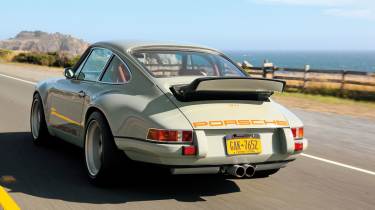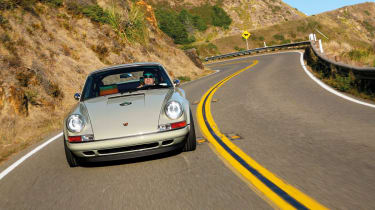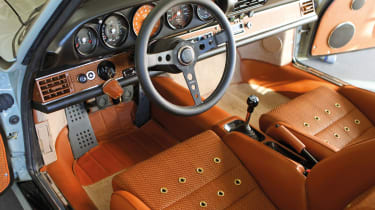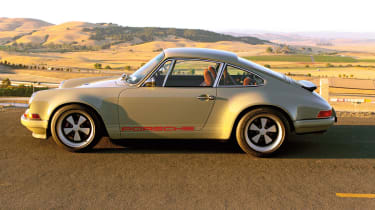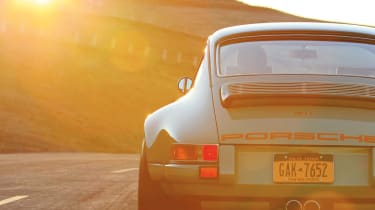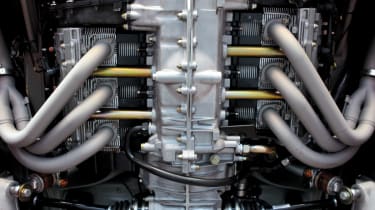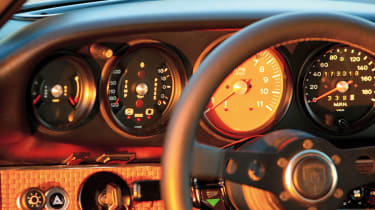Porsche 911 reimagined by Singer Vehicle Design - review
The Porsche 911 by Singer is one British man’s take on automotive perfection.
I know what you’re thinking. It can’t possibly drive as good as it looks. To be honest, that’s what I’ve been thinking since I first clapped eyes on Singer Vehicle Design’s mouth-watering attempt at the ultimate Porsche 911. Now, with the key to this spectacular $ 350,000 (£216,000) creation gripped in my gently perspiring hand, it’s the moment I’ve been simultaneously longing for and dreading.
You may already know the Singer story, but it’s one that’s worth repeating. Founded in 2009 by Rob Dickinson, a Los Angeles-based Brit with a degree in product design, a successful career as a rock musician and a life-long love of old-school Porsches, Singer Vehicle Design and the cars it creates are the physical embodiment of his all-consuming vision of the perfect 911.
An Englishman restoring and re-imagining the most iconic German sports car of all time from a workshop in Sun Valley, southern California, may sound like an unconventional business plan, but there’s method in his apparent madness; the area has been hot rod central since the end of the Second World War, for starters. Almost seven decades later, there’s an unrivalled network of highly skilled specialists doing world-class work, from interior trimmers and machinists to paint sprayers and fabricators. When it comes to building one-off cars, southern California has the expertise.
Perhaps unexpectedly, the region is also a noted hotspot of 911 nerds, thanks primarily to the semi-underground club known as the ‘R Gruppe’. Started in the ’90s, it remains a cultish collection of hardcore Porsche fanatics, many of whom work within the car industry as designers, engineers, racers and film-makers. Models from the ’60s and early ’70s are their drug of choice. Some cars are close to bone-stock, others highly modified, but all are completely personal to their owners. Dickinson counted himself amongst their number, but since embarking on the Singer project I sense that he and his creation now sit on the periphery of that scene – not exactly ostracised, but certainly marginalised by the extremes to which he has gone to satisfy his obsession.
I can see why this might be the case, for the Singer is a challenging and potentially controversial car. Is it retro? Dickinson hates the phrase, but with its 2.8 RSR-inspired, borderline-pornographic curves it’s natural to assume – at least superficially – that Singer is simply trying to evoke the past. The trouble with that theory is that the contours and surfacing of the bodywork are all Dickinson’s own work, so while he’s the first to admit where his influences came from, it is far from a shameless pastiche.
Then there’s the way the car has been put together. Singer only uses the very best suppliers, which is why this 911 has bespoke Hella xenon headlights, Recaro seats, Brembo brakes, a hand-built Cosworth-tuned motor, Öhlins TTX MkII dampers, a military-spec custom wiring harness and carbonfibre panels supplied by the Aria Group. Moreover, when Dickinson and his team can’t find something they’re happy with, they have it manufactured to their own exacting standards. To describe what they do as tuning, modifying or hot-rodding doesn’t come close to doing the project justice. This is a no-compromise car in every respect.
The first few Singers were based on the G-series 911, but this was soon changed to the later 964-generation cars. Dickinson believes (rightly, in my opinion) that the 964 represents the optimum blend of old-school feel and modern performance, so while there’s plenty of scope to enhance its sporting credentials, the dynamic and sensory experience is rooted in the air-cooled era. The result is a car with all the charisma and character of a classic 911, endowed with 21st-century performance and useability. It’s an incredibly appealing recipe, similar to that which Henry Pearman and Paul Brace created so successfully with their Eagle E-types.
Starting with scruffy but structurally sound 964 base cars (either sourced by Singer or supplied by the customer), each car is stripped back to its central monocoque, leaving the roof, pillars, front and rear bulkheads and floorpan. This is then media-blasted back to bare metal, after which it is seam-welded and strengthened where necessary for maximum structural integrity. A half-cage is also installed for safety, rigidity and a suitably road-racer look. The standard body panels – front and rear wings, bumpers, engine cover and even, if desired, the roof – are replaced with bespoke carbonfibre items. The doors remain steel to retain side-impact protection, not to mention that unmistakable thunk when you close them. The panel gaps are tighter than Tom Daley’s Speedos and the paintwork is absolutely flawless, in this case a fabulous original Porsche colour from 1958 called Stone Grey.
The engine is a masterpiece. Hand built by Cosworth in the US and mounted in a quilted leather-lined engine bay that’s more akin to an art gallery display case, it’s based upon the classic 3.6-litre flat-six but has been enlarged to 3.9 litres. Fitted with new Cosworth-designed cylinder heads and a state-of-the-art management system, the powerplant is blueprinted and coaxed to 380bhp, then mated to a freshly rebuilt six-speed gearbox and limited-slip differential. It’s a world away from the original 964 Carrera’s 247bhp. The engine in this model is in a ‘medium-hot’ state of tune, aimed at the keen road driver who might do the odd trackday. Depending on budget and intended use, Cosworth can also build a milder 3.6-litre 300bhp unit, or a 4-litre 425bhp motor for true headbangers.
Having all but dribbled saliva over the pristine exterior, I open the door to find the exquisite interior is equally magnificent. Tightly upholstered in the richest, softest aniline leather, it makes the recent 911 Sport Classic look a bit low-rent. The 964’s modern dials have all been re-faced to look like those from early cars, but they come across as convincing rather than contrived. The main crossmember that runs hidden beneath the dash is made from one piece of metal and the original organ-stop switches all have billet-machined mounts for solidity and tactile quality. Fans of the film Spinal Tap will also appreciate Dickinson’s cheeky homage – a Singer Racing Orange rev-counter that reads all the way to 11…
Then there’s the nickel. As standard the brightwork is polished aluminium, but it can be nickel-plated as an option. Warmer and more lustrous to the eye, this understated material perfectly complements the soft, period hue of this Stone Grey car and you can see it everywhere – window surrounds, engine grille, engine lid hinges, slam panel, light bezels, badging… Singer takes nickel plating to wonderful, perverted extremes.
There are so many exquisite details throughout this car that it’s impossible to do them all justice here, but I’ll pick one thing out to illustrate the scale of Dickinson’s fetishistic concern with things that only the most fastidious person would notice: the horn push in the middle of the gorgeous Momo Prototipo steering wheel. The standard plastic item offended Dickinson, so he had replacements machined by a local fabricator from billet. Each one is hand-polished, then fitted with an embossed leather Porsche crest. It costs a fortune to do, but it’s stuff like this that makes Dickinson tick, and one of the innumerable things his customers love about Singer’s work.It takes between five and six months for Singer to complete its painstaking transformation of a tired 964 into an entirely bespoke car, with a price tag of anything between $ 200,000 (£123,000) and $ 400,000 (£246,000) depending on specification. This particular car – commissioned by a customer in New York – is $ 350,000 and is due to be delivered just a few weeks after this test. This makes the owner’s pre-delivery offer to me all the more remarkable: spending a few days testing at Sonoma Raceway (formerly Sears Point) and on the roads around the Napa Valley to set the car up on its Öhlins dampers before taking it for an all-day blast on some spectacular northern California roads for final driving impressions and the photo shoot you see here.
Much like the retro look of the Singer, the driving experience messes with your mind. Sat amongst the woven leather, hands gripping that Momo wheel and feet resting on floor-hinged pedals, it’s all very old-school. Start the engine and it fires with a magnificently raucous holler before settling to a quick, pulsing idle. Throttle blips elicit immediate punches of noise and urgent spikes of revs, the anger and energy reminiscent of a classic competition engine, but with the smoothness and manners of a modern road car with electronic fuel injection.
The clutch is beautifully weighted and the gearshift – finessed to Singer-spec – is by far the best I’ve ever experienced in any 911. The steering is hydraulically power-assisted, and the weighting again feels so well-judged that you never question whether there’s too much or too little assistance. And after refining the suspension alignment and damper settings in our track and road test sessions, the steering response and precision feel equally instinctive.
I’ve never considered older 911s to be lacking in solidity and integrity, but this car feels incredibly together, as if the entire thing has been machined from one piece of material. There’s not a squeak or rattle to be heard or felt anywhere, while the Öhlins suspension has that reassuringly expensive feel that reeks of quality. It’s sports car firm, but the way it controls the 911’s body movement yet also rounds off any road imperfections is simply brilliant, especially as the car sits on fat 255/45 front and 275/40 rear rubber.
The stance is another area Dickinson obsesses about. Whenever the subject of ride height or front camber is mentioned at any stage during our set-up testing, his eyes narrow at the thought of messing with the magic. A lesser designer would sacrifice function for form in a heartbeat, but as I’m fast discovering, a Singer product cannot put aesthetics before dynamics. God knows how many sleepless nights this ethos has caused over the years, but they’ve been worth it for the way those wheelarches are filled to perfection by the deep-dished Fuchs rims. That it feels this good to drive at the same time is akin to discovering Angelina Jolie has the brain of Stephen Hawking.
One of the other surprises about this car is its homogeneity. Everything from the damping to the engine and exhaust note, from acceleration to agility, is hugely impressive without any single element dominating the experience. Consequently, as you gain confidence and push deeper into the throttle travel, lean ever harder on turn-in grip, stretch available traction or squeeze more from the brakes, everything else ups its game in unison. That makes it exciting, approachable and flattering to drive, which is not something you’d necessarily expect from a 380bhp 964-generation 911.
Heading through the canyons of northern California is about as close to driving nirvana as you can get. The roads are deserted, flowing endlessly with an infinite mix of corners, big gradient changes and breathtaking views of the Pacific coastline. We’re making prodigious progress and one helluva racket, the full-throttle shriek of this modernised air-cooled motor surpassed only by the fusillade of pops and bangs that spit from the twin stubs of the exhaust on a trailing throttle.
Wrung out through the gears, the Singer is gobsmackingly exciting and completely addictive. It has a voracious appetite for revs, and though tuned for a broad spread of torque, it continues to pull hard right through to the red line. It’s not quite as rabid as a 997 GT3 RS, but with 380bhp to fire just 1200kg down the road, the laws of physics dictate that it’s genuinely not far off (the Singer has 322bhp/ton, a 3.8 GT3 RS 329). What makes this performance all the more intoxicating is the way the Singer handles the power with enough aplomb to inspire, but retains enough of an edge to excite.
Fitted with regular Michelin Pilot Super Sport tyres, as opposed to more extreme Pilot Cup trackday rubber, it has a rare level of delicacy and allows you to work up to and beyond the limits of mechanical grip without it being a white-knuckle ride. Though much of the regular 964 suspension components have been uprated, its intrinsic balance remains. You’re more aware of the rearward weight bias than in a modern 911, but it’s there to be exploited rather than feared. And unlike the 964 RS with its heavy, unassisted steering, you’re better able to hustle the Singer and make quick inputs to keep it flowing, whatever the road throws at you.
There’s very little of that initial understeer found in stock ’80s and ’90s 911s, so you’re not grappling to get the thing turned in. That makes it great through really tight turns where you’re immediately working the front end hard, but it’s also brilliantly nimble and poised through medium-speed turns. And such is its balance and response through high-speed kinks, you just seem to think it through with barely a squeeze of additional pressure on the steering wheel. Consequently, it gives you the option of being neat and precise, or if you want to set it up with a cheeky lift on corner entry, you can light up the rear Michelins and scribe a lovely smoking arc through second- or third-gear turns, rear-end squatting ever so slightly, inside-front wheel unloaded but not airborne and the engine howling its approval in classic 911 style.
The brakes – a mix of Brembo discs and Porsche ‘Big Red’ calipers – also have that indomitable Porsche feel. Laden with feel and progression, and endowed with seemingly limitless stopping power, they’re more than man enough to cope with the motor’s searing performance. Despite being driven hard on some decidedly lumpen, British-style tarmac, there was never a hint of the ABS triggering prematurely, and the brakes worked brilliantly at Sonoma Raceway too. Considering the ambient temperature was over 30˚C, that’s very impressive.
Not wanting the day to end, we continue driving as the sun sets and darkness subsequently descends. With the moon rising and our work done, photographer Michael Alan Ross and I stand around the car in silence, staring at the 911 as though for the first time, eyes hungrily following every swoop and curve until it’s too dark to see.
Right from the first time I met Dickinson and his colleagues at the Los Angeles Auto Show a few years back, I knew their take on the 911 was dangerously desirable. Whether it could possibly deliver on its abundant visual promise or live up to its 2.7 RS-sized price tag were the elephants in the room. Not any longer. So convincing is the concept and so complete and cohesive the execution that this car oozes the right stuff with the same assurance as any Pagani Zonda or McLaren F1. What Singer does results in a car that transcends what you thought you knew about 911s to deliver a quite unique experience.
Regularly sampling cars so far above your pay grade leads you to develop a professional code much like that of a doctor – you don’t get emotionally involved. Unfortunately with cars like the Porsche 911 by Singer, that’s easier said than done. When the time finally comes to leave this heartbreakingly wonderful machine behind, I feel something akin to grief. I’m unlikely ever to have the funds to commission one of Dickinson’s masterpieces, but if I could have one – built to my precise specification – I’d never want another car.
SPECIFICATION
Porsche 911 by Singer Engine Flat-six, 3900ccPower 380bhp @ 6800rpmTorque 287lb ft @ 5500rpmTransmission Six-speed manual, rear-wheel drive, limited-slip diffFront suspension MacPherson struts, coil springs, adjustable dampers, anti-roll barRear suspension MacPherson struts, coil springs, adjustable dampers, anti-roll barBrakes Ventilated and drilled discs, 304mm front, 299mm rear, ABSWheels 8.5 x 17in front, 10.5 x 17in rearTyres 255/45 17 front, 275/40 17 rearWeight (kerb) 1200kgPower-to-weight 322bhp/ton0-60mph 3.9sec (estimated)Top speed 160mph (estimated)Price as tested $ 350,000 (£216,000)On sale Now (www.singervehicledesign.com)
